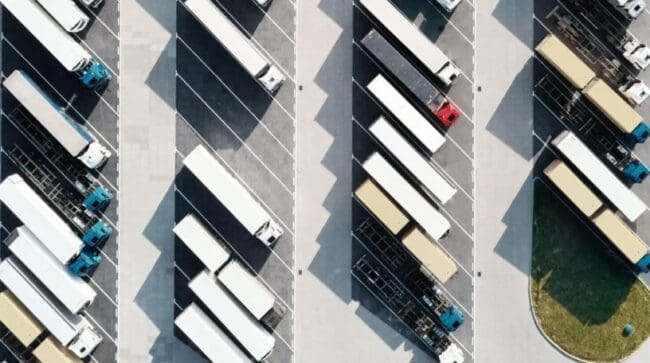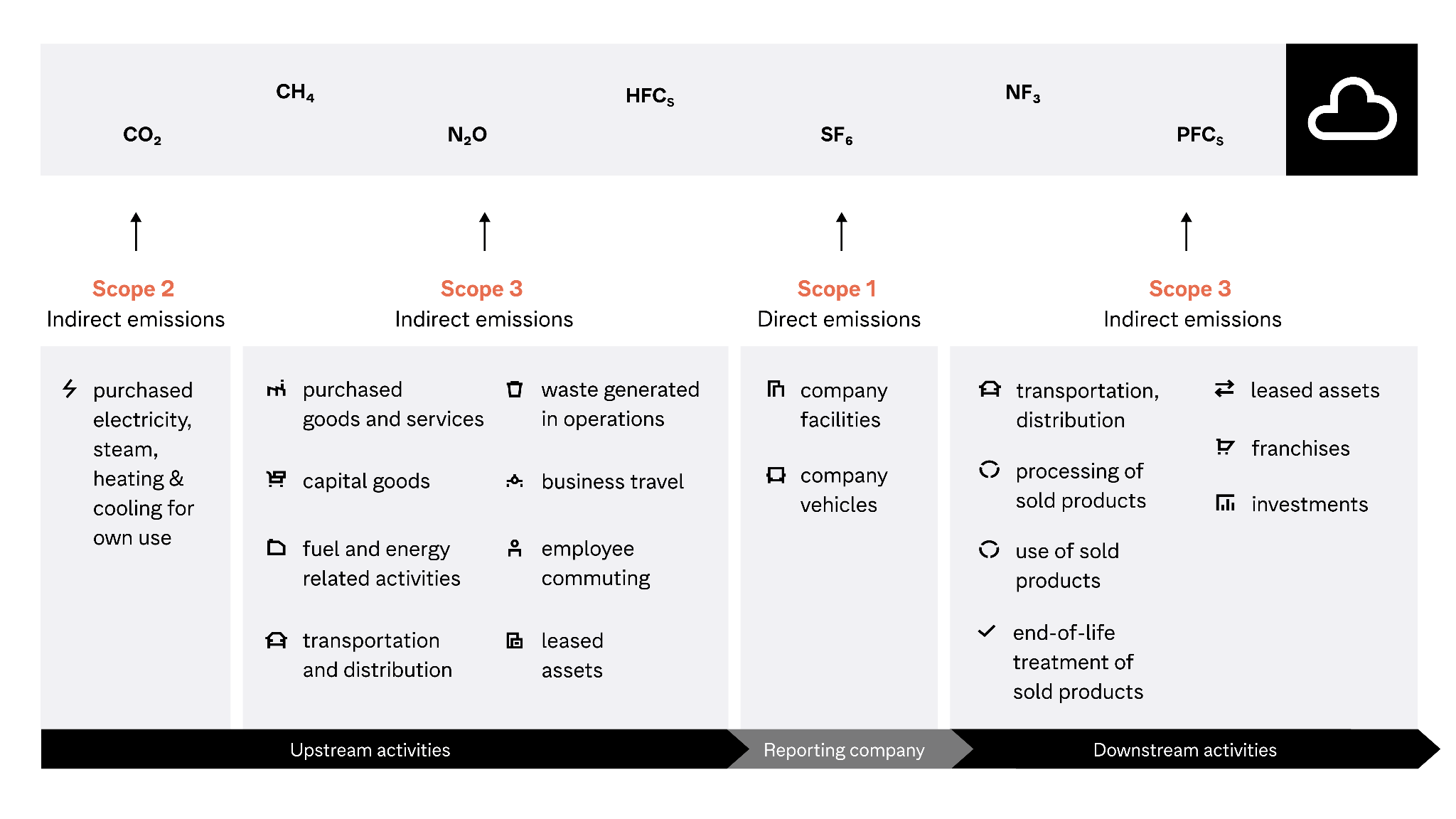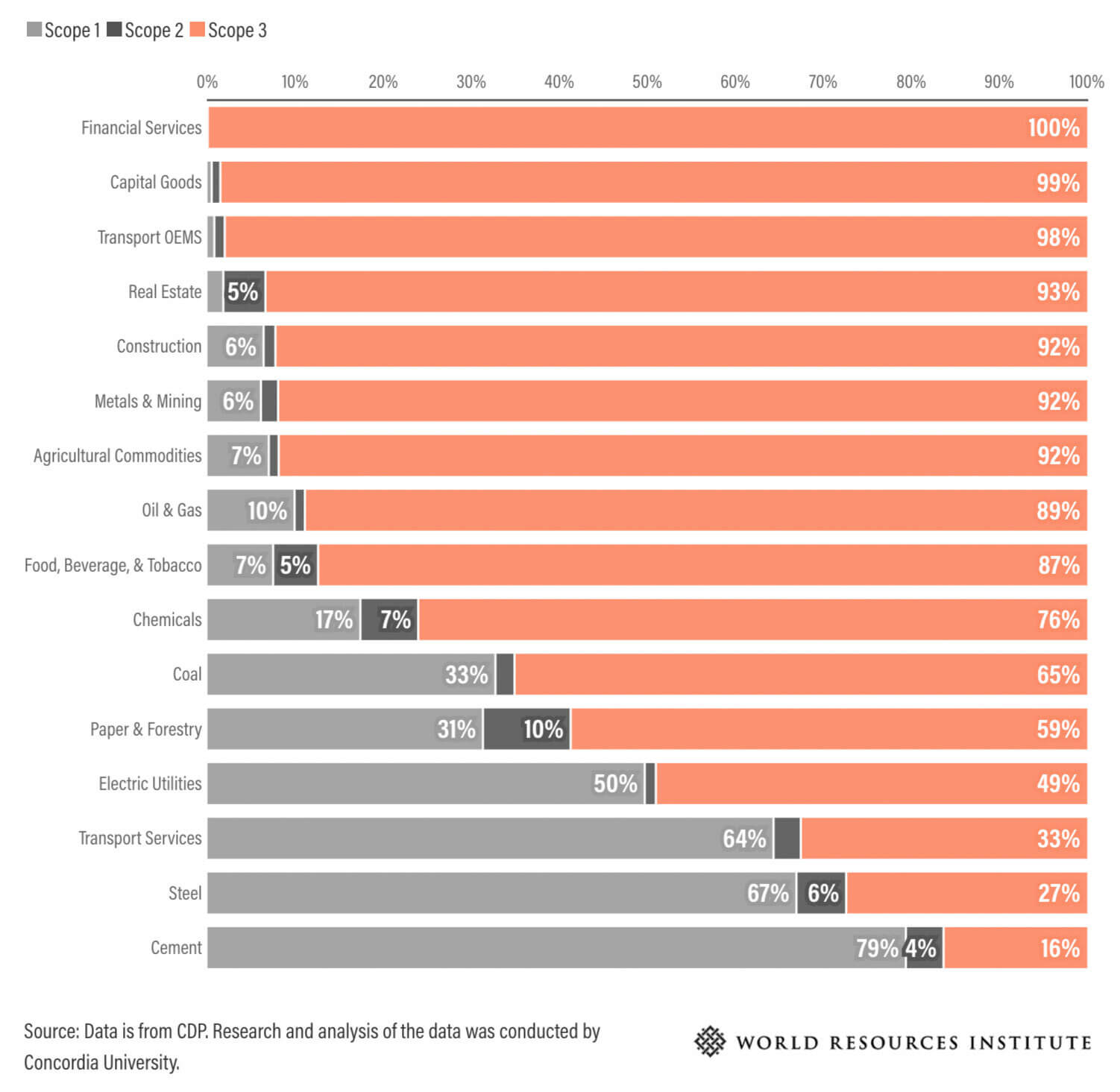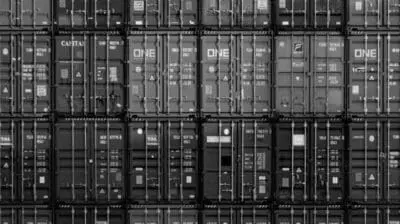Scope 3 emissions, explained

Value chain emissions in scope 3 are challenging – but vital – for businesses to address.
Businesses are increasingly motivated to monitor and reduce their carbon emissions as they strive to meet net-zero targets, avoid unintentional greenwashing, and secure the competitive advantages that stem from effective carbon management.
One vital source of emissions for businesses to address is scope 3: the emissions that originate in the value chain, outside of a business’s own operations.
Here’s what scope 3 emissions are, why they’re important, and how businesses can effectively manage them.
What are scope 3 emissions?
Scope 3 emissions are all indirect emissions that occur in the value chain of a company and that are not already included within scope 2 (the indirect emissions generated by the production of purchased energy).
These emissions – also known as value chain emissions – are a consequence of the company’s business activities but are generated by sources the company does not own or control.
Scope 3 emissions include:
- Emissions generated in the company’s supply chain, such as extraction, production, and transportation of purchased materials and fuels.
- Emissions generated from the use of sold products and services.
- Emissions generated from waste disposal. This includes the disposal of waste generated both in operations and in the production of purchased materials and fuels, as well as disposal of sold products at the end of their life.
(For a full list of scope 3 sources as defined by Greenhouse Gas Protocol, see the table in the Appendix at the end of this article.)
The Greenhouse Gas Protocol (GHG Protocol) – the most widely-used framework for calculating business carbon emissions – divides scope 3 emissions into upstream and downstream sources.
Upstream emissions come from the production of a business’s products or services, while downstream emissions come from their use and disposal.
The graphic below displays a business’s upstream and downstream activities, as well as the 15 categories of scope 3 emissions defined by the Greenhouse Gas Protocol:

Upstream & downstream emissions, explained
Learn more about the categories of scope 3 emissions and what they mean for your business’s carbon management strategy.
Read the article
While scope 3 emissions tend to be the largest source of emissions for most companies, there are stark differences across sectors.
On the high end, scope 3 emissions account for 99.98% of emissions in the financial services sector; on the low end, they are responsible for only 16% of emissions in the cement industry.
The graph below from the World Resources Institute breaks down the average emissions of 16 sectors, with data sourced from CDP:

Why are scope 3 emissions important for your business to address?
Across sectors, scope 3 emissions account for approximately 88% of emissions.[1]
This means that, more likely than not, scope 3 emissions constitute a significant share of your business’s carbon footprint – making them essential to include in your emissions reporting.
Depending on where your business is located, you may currently – or in the near future – be legally obligated to report your scope 3 emissions.

Check your emissions reporting requirements
Answer five simple questions to determine the mandatory reporting requirements, voluntary frameworks, and industry-specific guidelines that apply to your business.
However, businesses that effectively manage their scope 3 emissions earn benefits beyond legal compliance.
A comprehensive scope 3 strategy can help your business reduce its environmental impact, build brand equity, improve the efficiency of its procurement, implement circularity principles, and meet expectations from consumers, investors, and employees.
How do businesses reduce scope 3 emissions?
Reducing scope 3 emissions is challenging, as these emissions are outside of your company’s direct control.
The first step to reducing scope 3 emissions is to comprehensively and accurately account for them – after all, you can’t manage what you haven’t measured.
Businesses calculate their emissions through a process called carbon accounting. Because scope 3 emissions occur outside your business’s owned operations, it can be challenging to collect the data necessary for value chain carbon calculations, though automated solutions can accelerate the process.
Once you have calculated your business’s full value chain emissions, you can begin the process of reducing them. For many businesses, the most effective way to reduce scope 3 emissions is to engage their suppliers in emissions reductions. While there are many strategies for accomplishing this, there is a general plan that businesses can follow to begin engaging their suppliers.
A five-step plan for engaging suppliers in carbon management:
- Identify the most significant suppliers in terms of emissions.
- Set targets for emissions reductions with these suppliers.
- Work with suppliers to develop a plan for achieving these targets.
- Monitor progress and provide feedback to suppliers.
- Recognize and reward suppliers for their efforts.
This plan was excerpted from Normative’s comprehensive guide to value chain engagement. Download the free guide.
Use Normative to calculate & manage your full scope 3 emissions
Normative’s automated, science-backed carbon accounting engine empowers you to calculate your full carbon footprint, including your value chain emissions.
FAQs
Frequently asked questions about scope 3 emissions
Scope 3 emissions are all indirect emissions that occur in the value chain of a company and that are not already included within scope 2 ( the indirect emissions generated by the production of purchased energy).
Scope 3 emissions constitute a significant share of many companies’s carbon footprints, making them essential to include in emissions reporting and carbon reduction efforts.
Scope 3 emissions account for approximately 88% of greenhouse gas emissions across sectors.[1]
Businesses calculate their scope 3 emissions through a process called carbon accounting.
Because scope 3 emissions occur outside a business’s owned operations, it can be challenging to collect the data necessary for value chain carbon calculations. Automated carbon accounting tools can accelerate this process.
The first step to reducing scope 3 emissions is to comprehensively and accurately account for them. Then, you can begin the process of reducing them; for many businesses, the most effective way to reduce scope 3 emissions is to engage their suppliers in carbon reduction efforts.
Citations
[1] 88% is the median of the 2021 scope 3 emissions data of 16 CDP “high-impact sectors” (defined in this classification). We use the median instead of the mean as it’s more robust to outliers.
Appendix: scope 3 emissions categories as defined by the Greenhouse Gas Protocol
Refer to the Greenhouse Gas Protocol’s Technical Guidance for Calculating Scope 3 Emissions for a more detailed breakdown of the categories.
Upstream emissions scope 3 categories
| Category | Description |
|---|---|
| Purchased goods and services | Extraction, production, and transportation of goods and services purchased or acquired by the company |
| Capital goods | Extraction, production, and transportation of capital goods purchased or acquired by the company |
| Fuel- and energy-related activities | Extraction, production, and transportation of fuels and energy purchased or acquired by the company which are not already accounted for in scope 1 or scope 2 |
| Upstream transportation and distribution | Transportation and distribution of products purchased by the company, as well as other transportation and distribution services like inbound logistics, outbound logistics, and transpiration between company facilities |
| Waste generated in operations | Disposal and treatment of waste generated in the company’s operations, in facilities not owned or controlled by the company |
| Business travel | Transportation of employees for business-related activities in vehicles not owned or operated by the company |
| Employee commuting | Transportation of employees between their homes and their worksites in vehicles not owned or operated by the company |
| Upstream leased assets | Operation of assets leased by the company and not included in scope 1 and scope 2 |
Downstream emissions scope 3 categories
| Category | Description |
|---|---|
| Downstream transportation and distribution | Transportation and distribution of products sold by the company between the company’s operations and the end consumer |
| Processing of sold products | Processing of intermediate products sold by downstream companies |
| Use of sold products | End use of goods and services sold by the company |
| End-of-life treatment of sold products | Waste disposal and treatment of products sold by the company, at the end of the products’ lives |
| Downstreamleased assets | Operation of assets owned by the company and leased to other entities |
| Franchises | Operation of franchises in the reporting year, not included in scope 1 and scope2 |
| Investments | Operation of investments, including equity and debt investments and project finance |












